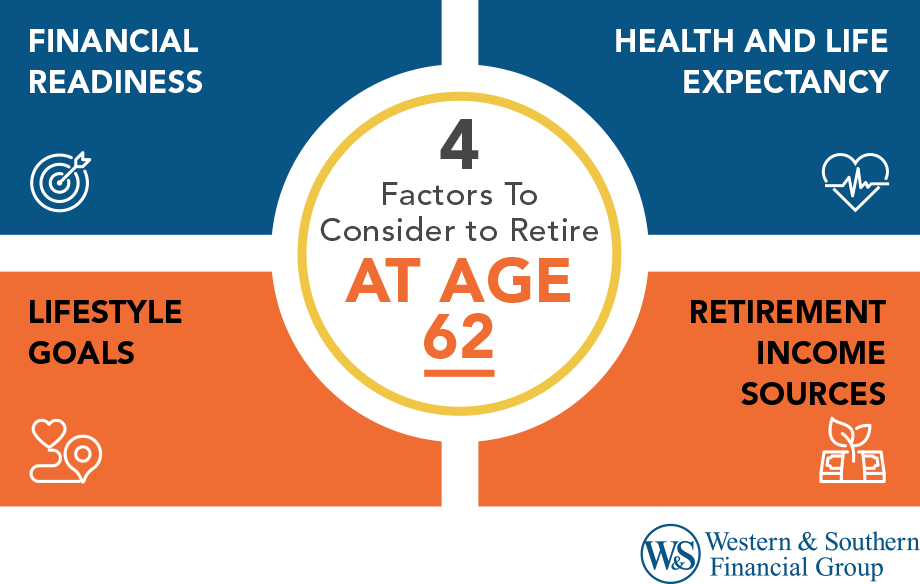

Key Takeaways
- Retiring at 62 can reduce your Social Security benefits by up to 30%, making planning for additional income sources essential.
- Estimating your retirement expenses, including healthcare costs until you become eligible for Medicare at 65, is crucial to ensuring financial stability.
- Experts suggest saving eight to ten times one's annual income by age 62, but many Americans must catch up, making careful planning necessary.
- Inflation and investment returns significantly impact your retirement savings, so a diversified portfolio is crucial in maintaining purchasing power.
- Working a few more years or considering part-time work can help extend your savings and increase your Social Security benefits.
Should I Retire at 62? Key Factors to Consider
Retiring at 62, the earliest age at which you can claim Social Security retirement benefits is a dream for many Americans. The prospect of leaving the workforce early and having more time to pursue hobbies, travel, and spend time with family is undeniably appealing. However, deciding whether to retire at 62 is a complex choice that requires careful consideration of your financial situation, health, and personal goals.
Financial Readiness
Financial preparedness is one of the most crucial factors in determining whether you can retire at 62. Consider the following:
- Debt and Expenses: Assessing and minimizing your debt before retiring is crucial to ensure your monthly expenses are manageable on your retirement income.
- Retirement savings: Do you have enough saved in 401(k)s, IRAs, and other accounts to support your desired lifestyle for 30+ years? The earlier you retire, the longer your savings need to last .
- Pension or other income: A pension or other reliable income sources can help offset lower Social Security benefits and provide greater financial flexibility.
- Healthcare costs: Retiring before Medicare eligibility at 65 means you must budget for health insurance. This can be a significant expense.
- Housing Costs: Housing is a significant retirement expense, so factor in mortgage or rent, maintenance, taxes, and utilities, and consider downsizing or relocating to lower costs.
- Inflation: Erosion of purchasing power makes it crucial to invest in ways that allow your savings to grow and keep up with rising costs.
- Investment Returns: Investment returns significantly impact how much you'll need to retire at 62, so having a diversified portfolio that balances growth and mitigates market risks is essential.
Health and Life Expectancy
Your health and anticipated life expectancy also play a role in deciding whether to retire at 62.
- Health Status: If you have chronic health conditions or a shorter life expectancy, retiring earlier to enjoy more leisure time may make sense. Conversely, if you're in good health and expect to live well into your 80s or beyond, you may want to work longer to avoid outliving your savings.
- Expected Lifespan: Planning for a longer retirement is essential to avoid outliving your savings as people live well into their 80s and 90s.
Lifestyle Goals
Think about what you want retirement to look like and whether retiring at 62 aligns with those goals:
- Lifestyle Choices: Whether extravagant or modest, your retirement lifestyle will significantly impact how much money you'll need to save.
- Do you have hobbies or travel plans you want to pursue while still young and active?
- Are you prepared for the potential loss of social connections and sense of purpose that work can provide?
Ultimately, the decision to retire at 62 is deeply personal and depends on your unique circumstances. It's essential to run the numbers, weigh the pros and cons, and consider seeking guidance from a financial advisor to ensure you make an informed choice. With careful planning and the right financial plan, retiring at 62 can be a fulfilling and financially viable option for many Americans.
What Are the Average Retirement Savings at 62?
Understanding the average retirement savings can give you a good sense of where you stand as you plan to retire at 62. Expert's rule of thumb typically recommends having about eight times your annual income saved by then.1
If you make $75,000 a year, you'd ideally want to set aside between $600,000 and $750,000. However, recent data shows that Americans aged 60 to 64 have an average savings of around $200,000 to $300,000, a significant shortfall for many.
Of course, your exact needs will vary based on your lifestyle, health, and other income sources like Social Security or pensions. If your savings aren't quite where you'd hoped, there are ways to catch up, such as working a bit longer or tweaking your investment strategy. The most important thing is to develop a plan that matches your retirement goals and helps you feel secure as you enter this new chapter of your life.
How to Calculate Your Future Retirement Expenses
One of the most critical steps in retirement planning is estimating your future expenses. Knowing how much you need to save and whether your retirement income will be sufficient is difficult without a clear picture of your anticipated costs. While predicting expenses decades in advance is an inexact science, there are strategies you can use to arrive at a reasonable estimate.
Start with Your Current Budget
Your current spending is the best starting point for projecting retirement expenses. Begin by tracking your expenditures for several months to understand where your money is going. Categorize expenses into buckets like:
- Housing (mortgage/rent, property taxes, insurance, maintenance)
- Utilities (electricity, gas, water, phone, internet)
- Food (groceries, dining out)
- Transportation (car payments, fuel, maintenance, public transit)
- Insurance (health, life, auto, long-term care)
- Healthcare (out-of-pocket costs, prescriptions, dental, vision)
- Personal expenses (clothing, haircuts, hobbies, entertainment)
- Travel and gifts
- Debt payments (student loans, credit cards)
- Savings and investments
Adjust for Retirement Lifestyle Changes
Next, consider how your expenses might change in retirement:
- Eliminate expenses: Certain costs, like retirement account contributions and work-related expenses (commuting, professional wardrobe), will disappear in retirement.
- Account for inflation: While some expenses may decrease, others, like healthcare, will likely increase over time due to inflation. Assume an annual inflation rate of 2-3% when projecting expenses.
- Factor in lifestyle goals: Do you plan to travel extensively in retirement or pursue expensive hobbies? Make sure to budget for these additional costs.
- Consider relocation: If you plan to downsize or move to an area with a lower cost of living, your housing and other expenses may decrease in retirement.
Adjust Healthcare Costs
Healthcare is one of the most significant expenses you'll face in retirement. If you retire at 62, you'll need to cover health insurance or out-of-pocket costs until you qualify for Medicare at 65. Even with Medicare, you'll still have to pay premiums, deductibles, and other out-of-pocket expenses.4
Don't Forget Taxes
Remember that a portion of your retirement income will likely go toward taxes:
- Account for tax-deductible expenses: Some retirement expenses, like charitable donations or medical costs, may be tax-deductible.
- Consider the tax implications of retirement account withdrawals: Withdrawals from pre-tax accounts like traditional 401(k)s and IRAs are taxed as ordinary income, while Roth account withdrawals are generally tax-free.
After estimating all your potential expenses, sum them up to get a rough idea of how much you'll need to retire at 62. Remember, this is just a starting point—your needs may change, so reviewing and adjusting your plan regularly is crucial.
Use a Retirement Expense Calculator
To help project future costs, consider using our retirement cost of living calculator . This calculator helps you compare your current cash flow to projected post-retirement income and expenses. After completing your inventory of income and expenses, your results will indicate an increase or decrease in your retirement income, expenses, and net cash flow.
Add Up All Your Potential Income Sources
To determine how much you need to retire at 62, calculate all potential income sources, such as Social Security, retirement accounts, pensions, savings, annuities, and possible part-time work. Let's break down the key areas that can contribute to your annual retirement income to get a clear picture of what's available to you.
- Social Security Benefits: When retiring at 62, Social Security monthly benefits will be lower than at full retirement age.3 So, checking your estimated benefits online and planning additional income sources is essential since Social Security typically covers only 40% of pre-retirement income.
- Retirement Accounts: Consider how much you can withdraw from your 401(k)s and IRAs each year without depleting your savings. Use the 4% rule as a guideline, but adjust based on your financial situation and market conditions.
- Pension Income: Review your pension plan before retiring to understand your payout options, including whether it offers survivor benefits. Pensions can provide a steady income stream based on your salary and years of service.
- Savings and Cash Reserves: Ensure you have sufficient savings and cash reserves to cover 6-12 months of living expenses. This will offer financial stability and flexibility in case unexpected costs arise or if other income sources fall short.
- Annuities: Annuities provide a steady income stream in retirement, offer tax-deferred growth, and ensure you don't outlive your savings, but it's essential to understand their types and how they fit into your overall plan.
- Part-Time Work: Consider part-time work in retirement to supplement income and delay withdrawals from retirement accounts. This can extend your savings and provide extra funds for leisure or unexpected expenses.
Stress Test Your Budget
Once you have a retirement budget, assess whether your anticipated income sources (Social Security, pensions, retirement account withdrawals) will cover your estimated annual retirement expenses:
- Use a retirement calculator to project your retirement account balances based on different contribution and return scenarios.
- If there's a shortfall, you may need to save more, work longer, or adjust your planned lifestyle
By thoroughly evaluating your current and future expenses, factoring in lifestyle changes and taxes, and stress-testing your retirement budget, you can develop a realistic estimate of how much you'll need to save to fund your desired retirement.
Tips for Retiring Comfortably at 62
Many dream of retiring at 62, but making that dream a reality requires careful planning. Here are some practical tips to help you retire comfortably at 62 and ensure the financial security you need for your golden years.
- Maximize Social Security Benefits: Consider delaying Social Security benefits to increase your monthly check; if you must start at 62, create a careful budget to make the most of reduced payments.
- Review Your Retirement Accounts: Review your retirement accounts, such as your 401(k) and IRA, to ensure you're on track. Consider working longer or adjusting your investment strategy to boost savings if needed.
- Consider Healthcare Costs: Since Medicare starts at 65, plan for healthcare costs. Consider private insurance or using a spouse's coverage, and budget for premiums and out-of-pocket expenses.
- Plan for Life Expectancy: Ensure your retirement savings can last 30 years or more by planning for longevity, considering inflation's impact, and adjusting your investment strategy to maintain purchasing power.
- Diversify Your Income Sources: To help enhance financial security, supplement Social Security with part-time work, rental income, or annuities.
- Reduce Debt Before Retiring: Before retiring, focus on paying off high-interest debts like credit cards and personal loans, which will provide more financial flexibility and help preserve your savings.
- Create a Retirement Budget: Create a detailed retirement budget based on your income and expenses, and regularly review it to avoid outliving your savings.
- Consult a Financial Planner: Consult a financial planner to develop a personalized strategy that includes tax-efficient withdrawals, suitable investments, and long-term planning.
Retiring at 62 is achievable with careful planning and intelligent financial decisions. By estimating your expenses, maximizing Social Security, reviewing your savings, and considering healthcare costs, you can build a retirement plan that allows you to enjoy life comfortably after leaving the workforce.
Conclusion
Retiring at 62 can be a good choice if your financial situation is secure, you have health concerns, or you’re ready to enjoy your retirement years. However, if you can continue working and delay benefits, you might enjoy a more comfortable retirement later on. Consulting with a financial planner can help you weigh these factors and make the best decision for your unique circumstances.
Start planning today to achieve your retirement goals at 62. Start Your Free Plan
Frequently Asked Questions
What is the average retirement income at age 62?
What is a good net worth at 62 years old?
What is good retirement?
What age is best to retire?
Should I pay off my mortgage before retiring?
Sources
- Here's how much money you should have saved at every age. https://www.cnbc.com/select/savings-by-age.
- What is the 4% rule? https://www.cnn.com/cnn-underscored/money/four-percent-rule-retirement.
- Starting Your Retirement Benefits Early. https://www.ssa.gov/benefits/retirement/planner/agereduction.html.
- Estimate my Medicare eligibility & premium. https://www.medicare.gov/eligibilitypremiumcalc.







